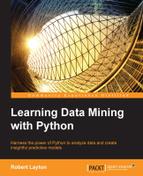Book Description
Harness the power of Python to analyze data and create insightful predictive models
In Detail
The next step in the information age is to gain insights from the deluge of data coming our way. Data mining provides a way of finding this insight, and Python is one of the most popular languages for data mining, providing both power and flexibility in analysis.
This book teaches you to design and develop data mining applications using a variety of datasets, starting with basic classification and affinity analysis. Next, we move on to more complex data types including text, images, and graphs. In every chapter, we create models that solve real-world problems.
There is a rich and varied set of libraries available in Python for data mining. This book covers a large number, including the IPython Notebook, pandas, scikit-learn and NLTK.
Each chapter of this book introduces you to new algorithms and techniques. By the end of the book, you will gain a large insight into using Python for data mining, with a good knowledge and understanding of the algorithms and implementations.
What You Will Learn
- Apply data mining concepts to real-world problems
- Determine the author of a document based on their writing style
- Use APIs to download datasets from social media and other online services
- Find and extract good features from difficult datasets
- Create models that solve real-world problems
- Design and develop data mining applications using a variety of datasets
- Set up reproducible experiments and generate robust results
- Recommend movies, online celebrities, and news articles based on personal preferences
- Compute on big data, including real-time data from the Internet
Downloading the example code for this book. You can download the example code files for all Packt books you have purchased from your account at http://www.PacktPub.com. If you purchased this book elsewhere, you can visit http://www.PacktPub.com/support and register to have the files e-mailed directly to you.
Table of Contents
- Learning Data Mining with Python
- Table of Contents
- Learning Data Mining with Python
- Credits
- About the Author
- About the Reviewers
- www.PacktPub.com
- Preface
- 1. Getting Started with Data Mining
- 2. Classifying with scikit-learn Estimators
- 3. Predicting Sports Winners with Decision Trees
- 4. Recommending Movies Using Affinity Analysis
- 5. Extracting Features with Transformers
- 6. Social Media Insight Using Naive Bayes
- 7. Discovering Accounts to Follow Using Graph Mining
- 8. Beating CAPTCHAs with Neural Networks
- 9. Authorship Attribution
- 10. Clustering News Articles
- 11. Classifying Objects in Images Using Deep Learning
- 12. Working with Big Data
- A. Next Steps…
- Chapter 1 – Getting Started with Data Mining
- Chapter 2 – Classifying with scikit-learn Estimators
- Chapter 3: Predicting Sports Winners with Decision Trees
- Chapter 4 – Recommending Movies Using Affinity Analysis
- Chapter 5 – Extracting Features with Transformers
- Chapter 6 – Social Media Insight Using Naive Bayes
- Chapter 7 – Discovering Accounts to Follow Using Graph Mining
- Chapter 8 – Beating CAPTCHAs with Neural Networks
- Chapter 9 – Authorship Attribution
- Chapter 10 – Clustering News Articles
- Chapter 11: Classifying Objects in Images Using Deep Learning
- Chapter 12 – Working with Big Data
- More resources
- Index
